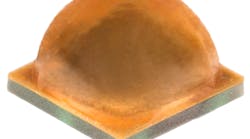This article was published in the October 2013 issue of LEDs Magazine.
Visit the LEDs Magazine archive page and view the E–zine version in your browser. You can download a PDF of the magazine from within the browser E–zine.
+++++
As LED chips quickly approach their theoretical limits for efficient light output, incremental improvements to the LED die provide diminishing returns on investment. This presents a dual challenge to LED manufacturers, who are feeling the pressure to optimize the lumen-per-watt efficacy of their devices while simultaneously driving down costs. This challenge is particularly acute for manufacturers competing for the rapidly expanding opportunities in general solid-state lighting (SSL) applications — but optical silicones can help.
Lighting consumes nearly 20% of global electricity generation, according to the United Nations en.lighten initiative. This fact has not only prompted governments around the world to plan or implement stringent new energy-efficiency regulations, it has sparked growing competition from LED manufacturers for a share in the expanding general lighting market.
As designers look beyond the technological status quo to boost lumen output and streamline costs, many are showing interest in optical silicone technology. As a class of materials, silicones are driving greater reliability, performance, and cost efficiency in applications spanning the entire LED value chain. Easily molded, these versatile materials are finding application as optically clear encapsulants or highly reflective LED packaging elements. In either case, silicone technology offers expanded design latitudes for shaping light and improving LED reliability.
Silicones also deliver high thermal and photostability compared to organic materials, such as epoxies or plastics. This stability is an important consideration as LED designers increase the amount of drive current in their devices and decrease the overall size of lighting fixtures. Combined, these trends are pushing LED temperatures to 150°C and higher, which can cause conventional epoxies and plastics to turn yellow and physically degrade over time. In contrast, silicones have demonstrated reliable optical and physical performance at temperatures reaching 200°C and higher. This range helps ensure next-generation LEDs can meet and exceed the lumen maintenance requirements of challenging packaging applications.
Many LED manufacturers may already be familiar with these properties of silicones. Yet many are unaware that not all optical-grade silicones are created equal. While all silicones share the same basic silicon-oxygen building blocks, they actually fall into two distinct chemistries characterized either by phenyl or methyl end groups distributed along their molecular backbone.
The differences between phenyl and methyl chemistry pose significant real-world implications for LED manufacturers. Namely, phenyl-based silicones deliver a comparatively higher refractive index (RI) of 1.54 vs. the 1.41 exhibited by methyl-based technologies. Although small, this difference in RI can translate into about 7% more light output — independent of the LED chip, case, or input power.
In other words, phenyl-based optical silicones enable LED designers to boost LED output simply by changing encapsulant materials. Such a materials choice signals a more cost-effective alternative to achieving a comparable improvement in LED chip performance.
Traditionally, the view among many veteran LED designers and manufacturers was that phenyl silicones came with certain limitations when it came to thermal stability — but no more. Breakthroughs in phenyl-based silicone chemistry now enable optical silicone encapsulants to perform with exceptional reliability in the latest generation of chip-on-board LED architectures.
Further, phenyl-based silicone encapsulants provide comparatively higher mechanical strength, and stronger gas barrier properties. This quality is particularly important for protecting delicate LED components such as phosphors or silver electrodes against moisture deterioration and sulfur corrosion. Because LED electrodes double as reflective elements and phosphor is a key element of light conversion, enhanced gas barrier protection is absolutely critical to maintaining both the performance and reliability of LED output.
We expect a key factor in the worldwide growth of LED-based lighting to be driven largely based on the adoption of high-RI materials. Advances in phenyl silicone technology have come just in time to improve the efficiency, reliability, and competitive value of LEDs as manufacturers target new applications emerging in today's general lighting market.






